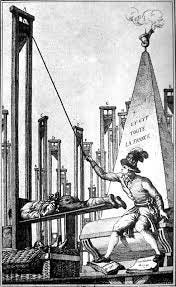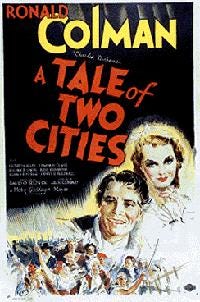Robespierre, a major architect of The Terror, shown guillotining France, having killed everyone else.
My obsession
In my short story collection Old Babes in the Wood, there’s a story called “Airborne” about three old female academics, one of whom — Leonie – is a scholar of the French Revolution. She refers to it familiarly as “the French Revvie,” and has written a book about it, concerning the vengeful period right after the fall of Robespierre known as the Thermidorian Reaction.
The name refers to the Revolution’s new name for (more or less) August --Thermidor, because it was hot– and the publishers of the book, hoping to boost sales, dump the subtitle —”Extra-judicial Political Reprisals and Grudge Killings During the Thermidorean Reaction of the French Revolution and Their Legacy For Today” – add an exclamation mark after Thermidor!, and do the cover up in Toulouse Lautrec Belle Epoque lettering, giving readers the impression it’s a fancy French seafood cookbook. Naturally they’re outraged to be confronted with pictures of Robespierre being shot in the face and counter-revolutionaries hacking their enemies to death. Well, you can imagine.
I am not Leonie – she’s tall, for one thing — but her obsession with the French Revvie is also mine. Since what happened shortly after the Thermidorean Reaction was the advent of Napoleon, naturally I had to see the movie.
The Battle of Austerlitz, Napoleon’s tactical masterpiece and biggest win.
Napoleon, the movie
I went to an actual cinema, and enjoyed myself a lot. It was sort of like Scrooge revisiting his past — “Look! Here comes The Battle of Austerlitz! Oh oh, he’s invading Russia! Mistake! Where’s the winter underwear? Oh no, now Josephine dies,” etcetera.
Top marks to the ladies’ hats — well done, costume designer! Josephine doesn’t have black teeth as she did in life, but we can forgive that, as she’s dead smouldering glam. Napoleon is played at times like a sofa, but maybe he could be a bit like that. Battle of Waterloo — super (drone-filmed?) shot of the British Square in action. Questions were raised in my mind about all the white leggings, or gaiters — wouldn’t they get awfully muddy? – but they’re accurate, according to paintings. Marie Antoinette didn’t have that much hair when she was executed, but she wasn’t as old and ugly as she’s shown in the David sketch, according to the death mask — taken by Mme Tussaud while the gravediggers were on lunch break, according to legend – so the film is probably more accurate. Thus I nitpicked my way from scene to scene, wondering occasionally what those who’d actually been there would think of this picturesque reenactment of their lives, which must have been fraught, saturated with violence, and very, very scary.
Here is the Battle of Waterloo through eyewitness accounts, French and English, with lots of pictures. Read about Waterloo Teeth! Discover the story of Wellington’s second in command’s amputated leg, and the shrine erected to it! Learn how some French soldiers escaped through the woods, while others got trapped in a traffic jam! More!
A Tale of Two Cities, the 1935 movie
The origin of my French Revvie obsession was probably the inclusion of Dickens’ A Tale of Two Cities on the high school curriculum, circa 1953. Why it? For the same reason we got Julius Caesar early on, I expect: no sex in it. Just a lot of bloodshed. (Sexual assault takes place in the Dickens but off the page, and the woman dies as a result, so message delivered to high school juniors: a) Aristocrats are bad! and b) Sex will kill you. Things a young girl should know.)
So of course, in preparation for Napoleon, I dredged up the 1935 Tale of Two Cities, starring Ronald Coleman as Sydney Carton. (Hint: I always pay attention to Dickens’ names, because he did. Sydney proably derives from Saint Denis, who was martyred by having his head cut off. Carton was at that time a word for pasteboard; so, flimsy, not solid.) Coleman plays Hamlet-ish, and the actors playing Lucie and Darnay enact store mannequins, as is usual with Dickens’ romantic couples. (Is Lucie really a fugitive from The Stepford Wives? Don’t rule it out.) The revolutionary and vengeful Madame Defarge, played by Blanche Yurka, is incandescent, and steals every scene she’s in.
As Sydney Carton goes to his selfless death, having replaced Darnay in prison, my watching companion said, “He hasn’t said, ‘It is a far, far better thing I do…” Me: “He’ll say it, don’t worry.” “But he’s going up the steps!” “He’ll say it.” “But the blade is falling!” “He’ll say it.”
He said it.
Next time: What is “revolution”? Not what you may think! Why is the French Revvie so important? Hang by your thumbs! What can the life of Robespierre tell us? Eek!
Meanwhile, here are three books: two novels and a biography. I don’t know how to make these pictures line up side by side. Sorry about that.
Hilary Mantel’s A Place of Greater Safety is the deeply researched story of Robespierre, Danton, and Camille Desmoulins, chums in youth and initially fellow architects of the Revolution and the Terror, until they diverged and Robespierre arranged for the conviction and execution of his former friends. (Only – not long after – to have his own head chopped off.)
Edward Carey’s Little is the truly remarkable life of the tiny Mme Tussaud, who narrowly avoided execution herself. Painters and writers and artists of all kinds led perilous lives in perilous times – every time the government changed they were subject to scutiny based on who they’d been working for. But Mme T. made it through!
Fatal Purity, by Ruth Scurr, is the life of Robespierre in great detail. What made him tick? If you don’t know by the end of this exhaustive and aptly-named biography, nobody ever will.
Keep reading with a 7-day free trial
Subscribe to In the Writing Burrow to keep reading this post and get 7 days of free access to the full post archives.











